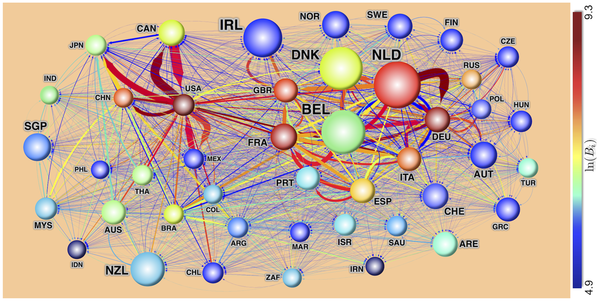Complex Global Network Makes Food Poisoning Outbreaks Hard to Track

Salmonella, E. coli and other food-related diseases outbreaks can sicken and kill with sweeping effectiveness. Getting to the root of these outbreaks is a difficult task made even harder by global trade.
The ingredients in your favorite dish may have begun the journey to your plate from dozens of diverse countries across the globe. The diverse and complex food traffic network makes your meal delicious but can also cause headaches when a food-related disease outbreak occurs.
The new study, led by Jozsef Baranyi, PhD, from the Institute of Food Research at Norwich Research Park, highlights the vast web of food commerce as the culprit behind the difficulty in identifying which food is the cause for a poisoning outbreak.
A recent salmonella outbreak in America was found to have originated from a mail-order hatchery in Ohio. While investigators were able to get to the source of the food poisoning outbreak rather quickly, 93 people across 23 states were sickened by the tainted food.
In 2011, an E. coli outbreak in northern Germany caused 45 deaths and 3,785 were sickened by the disease beginning on May 2. Around three weeks after the first reports of the E. coli outbreak, cucumbers from Spain were deemed to be the culprit and were quickly pulled from the shelves. The source of the cucumbers, two greenhouses located in Andalusia, was found to have no traces of E. coli contamination. Cross-contamination could have occurred while the cucumbers made their way into Germany but the vegetables were soon ruled out as the cause of the E. coli outbreak. It was not until June 5, 2011 that local bean sprouts were found to be the source of the E. coli outbreak.
The new study highlights how any delay in identifying the source of the contamination can lead to greater numbers of individuals affected while governments and companies can also be negatively affected by the inability to pinpoint the outbreak's source. Researchers collected import and export data from the United Nations to reconstruct the global food traffic network.
The study shows that even small countries, like the Netherlands, could be a hot spot for contamination. The Netherlands had around $129 billion in total import and export for 2008 and is a crucial hub for trade. That means that tracking a possible outbreak in The Netherlands, or other countries that The Netherlands trades with, would be incredibly difficult because of how much food enters and leaves the Netherlands each year.
Because of globalization, food outbreaks may occur more often than before. To help reduce the effects of possible food outbreaks in the future, some have called for ways to monitor food trade or for companies and governments to collect and share information. This would not only help limit the damage of a food poisoning outbreak but may also help reduce food waste, leading to better food distribution.
The study was published in PLoS ONE.
Published by Medicaldaily.com



























